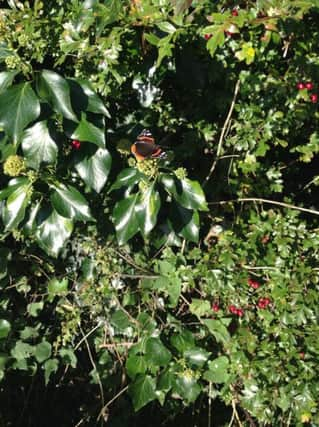Majestic encounter among the berries


In our vegetable garden, we are still harvesting late crops of courgettes, rocket, beans, carrots and beetroots.
Out walking at the weekend, I noticed a Red Admiral butterfly soaking up the sunshine in a sheltered spot at the foot of an old ash tree.
Advertisement
Hide AdAdvertisement
Hide AdAll around the tree’s trunk, the nectar rich flowers of Hedera, better known as common ivy, were abuzz with honey bees and other insect life, making it impossible to believe that we are already approaching the end of October. Out in the countryside, the changing foliage tells a different story; the rich tones of autumn have replaced the vibrant greens of summer and fallen leaves crunch beneath my feet.
The hedgerows are heavy with the ruby red berries of hawthorn and guelder rose, and the burnt orange of rose- hips. If you make sloe gin, you will probably have found that the blue-black berries of the blackthorn bush are scare this year.
I’ve discovered a meagre supply, but there are nowhere near as many as last year.
I usually pick them after there has been a sharp frost as it softens their skins, allowing their flavour to permeate through into the gin more easily, but, as we are still awaiting the first real cold snap of the winter, I will probably end up mimicking the effect by putting them in the freezer for an hour or so first. Sloes aside, the autumn countryside is a forager’s paradise.
Advertisement
Hide AdAdvertisement
Hide AdOn a recent walk at Skipwith Common, my family and I spotted all manner of weird and wonderful fungi emerging from rotten tree stumps and springing up in damp, shady spots along the woodland path.
Nothing tastes as good as wild field mushrooms cooked simply in butter, but it is important to be absolutely sure that you know which varieties are edible before picking them.
If you’re in doubt, don’t risk it.Many of the fields near where I live have not yet been ploughed and the vast tracts of corn stubble are a perfect hunting ground for birds of prey. Immediately after the corn was harvested, I saw a barn owl out hunting during the middle of the afternoon on an almost daily basis for two or three weeks.
As they are nocturnal, I concluded that it must be feeding young, perhaps a second brood hatched in late summer.
Advertisement
Hide AdAdvertisement
Hide AdOne morning, as I walked along the perimeter of a stubble field with my dogs, a startled buzzard rose up from the sun-bleached grass just a few feet away from us. It took me by surprise but gave Wolfie, my German Shepherd, a real scare as she had been strolling along the very edge of the field closest to where it emerged.
As the buzzard took flight, there was a surreal, breathtaking moment when the magnificent creature was just a couple of feet above her head and she gave an anxious glance upwards. This rare opportunity to see a buzzard at close range – and alongside a large dog like Wolfie – made me realise what a huge wingspan they have and just how beautiful they are.
We watched in awe as it soared skywards. I then wandered over to the grassy nook where it had been lurking, wondering what had attracted it to the ground.
There I discovered the half-eaten – and very neatly butchered – carcass of a rat; we’d clearly disturbed breakfast. It was a memorable encounter that made my day.